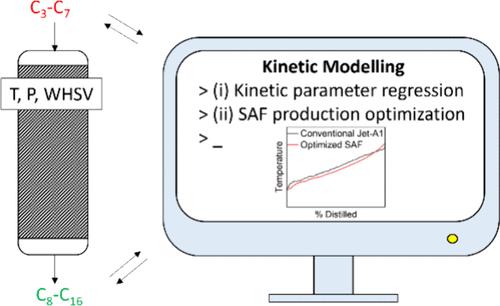当前位置:
X-MOL 学术
›
ACS Sustain. Chem. Eng.
›
论文详情
Our official English website, www.x-mol.net, welcomes your
feedback! (Note: you will need to create a separate account there.)
Optimization of Sustainable Aviation Fuel Production through Experiment-Driven Modeling of Acid-Catalyzed Oligomerization
ACS Sustainable Chemistry & Engineering ( IF 7.1 ) Pub Date : 2024-11-15 , DOI: 10.1021/acssuschemeng.4c08240 Florent J. Dubray, Vladimir Paunovic, Jeroen A. van Bokhoven
ACS Sustainable Chemistry & Engineering ( IF 7.1 ) Pub Date : 2024-11-15 , DOI: 10.1021/acssuschemeng.4c08240 Florent J. Dubray, Vladimir Paunovic, Jeroen A. van Bokhoven

|
To reduce the aviation industry’s greenhouse gas emissions, sustainable aviation fuel (SAF) is needed. Therefore, a methanol-to-SAF process comprising (i) methanol to olefin (MTO), (ii) olefin oligomerization, and (iii) olefin hydrogenation reaction steps is a promising route. The olefin oligomerization step is responsible for resulting SAF properties and needs to be optimized in concert with the previous MTO step. For this purpose, a kinetic model using a total of seven kinetic parameters was designed from a limited number of experimental measurements, allowing us to successfully describe the oligomerization reactivity of various olefin mixtures over an acid catalyst in flow. This inexpensive model predicted optimal reaction conditions and feed compositions, resulting in product mixtures with properties matching those of conventional Jet-A1 aviation fuel. To maximize SAF-range products, a feed composed of C4 and C5 olefins is most desirable, while controlled C3, C6, and C7 olefin cofeeding and C4/C5 olefin feed ratio are required to finely tune the SAF product composition. This modeling approach allows for efficient process optimization directed toward the synthesis of SAF with controlled properties and composition. Additionally, precise MTO–olefin compositions can be predicted for the optimal production of high-quality SAF, pointing toward the development of an efficient overall methanol-to-SAF process.
中文翻译:

通过酸催化低聚化的实验驱动建模优化可持续航空燃料生产
为了减少航空业的温室气体排放,需要可持续航空燃料 (SAF)。因此,包括 (i) 甲醇制烯烃 (MTO)、(ii) 烯烃低聚化和 (iii) 烯烃加氢反应步骤的甲醇制 SAF 工艺是一种很有前途的途径。烯烃低聚化步骤负责产生 SAF 特性,需要与之前的 MTO 步骤一起进行优化。为此,从有限数量的实验测量中设计了一个使用总共七个动力学参数的动力学模型,使我们能够成功描述各种烯烃混合物在流动中的酸催化剂上的低聚反应性。这种廉价的模型预测了最佳反应条件和进料成分,从而产生具有与传统 Jet-A1 航空燃料特性相匹配的产品混合物。为了最大限度地利用 SAF 系列产品,最理想的是由 C4 和 C5 烯烃组成的原料,而需要受控的 C3、C6 和 C7 烯烃联合进料以及 C4/C5 烯烃进料比例来微调 SAF 产品成分。这种建模方法允许对工艺进行高效优化,以合成具有受控特性和成分的 SAF。此外,可以预测精确的 MTO-烯烃组成,以最佳方式生产高质量的 SAF,从而为开发高效的整体甲醇制 SAF 工艺指明方向。
更新日期:2024-11-16
中文翻译:

通过酸催化低聚化的实验驱动建模优化可持续航空燃料生产
为了减少航空业的温室气体排放,需要可持续航空燃料 (SAF)。因此,包括 (i) 甲醇制烯烃 (MTO)、(ii) 烯烃低聚化和 (iii) 烯烃加氢反应步骤的甲醇制 SAF 工艺是一种很有前途的途径。烯烃低聚化步骤负责产生 SAF 特性,需要与之前的 MTO 步骤一起进行优化。为此,从有限数量的实验测量中设计了一个使用总共七个动力学参数的动力学模型,使我们能够成功描述各种烯烃混合物在流动中的酸催化剂上的低聚反应性。这种廉价的模型预测了最佳反应条件和进料成分,从而产生具有与传统 Jet-A1 航空燃料特性相匹配的产品混合物。为了最大限度地利用 SAF 系列产品,最理想的是由 C4 和 C5 烯烃组成的原料,而需要受控的 C3、C6 和 C7 烯烃联合进料以及 C4/C5 烯烃进料比例来微调 SAF 产品成分。这种建模方法允许对工艺进行高效优化,以合成具有受控特性和成分的 SAF。此外,可以预测精确的 MTO-烯烃组成,以最佳方式生产高质量的 SAF,从而为开发高效的整体甲醇制 SAF 工艺指明方向。


















































 京公网安备 11010802027423号
京公网安备 11010802027423号